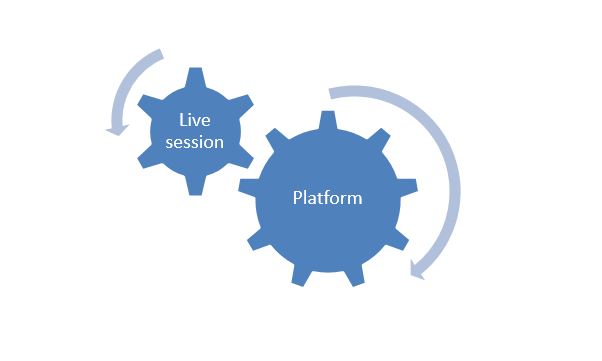The bigger picture when you teach online
The bigger picture when you teach online
Teachers have done an amazing job quickly working out how to use new videoconference systems for their live sessions. I have been working with several schools and universities, helping to train teachers and get everyone set up with delivering ‘live’ sessions. The one thing to remember is that the ‘live’ session is only half the story. In fact it is less than half the story. When we organise online learning, there are essentially two parts. Yes, we need to do live teaching but what do the students do after our lesson? How are we organising our students? How are we communicating with them, giving them homework and tracking what they are doing? The videoconference systems can’t do this. That is where the other half of the story comes in.
Many teachers are contacting me because they are overwhelmed with dealing with all the other parts after the live lesson. They are inundated with emails from students. They don’t know how to organise setting and marking their student’s homework and where to get the students to share it. The key is to have a platform where students can find the homework you have set, access the audio and video from the book and revise the lesson. Luckily, most publishers have platforms that offer interactive versions of their books, often with extra activities, tests, audio and video all thrown in. They often include the ability to communicate with the students and even the ability to track what homework they have done. This is the ideal complement to a live lesson since the platform provides a way to organise the students, provide actvities and track their activity.
If you are lucky enough to work with a publisher that has a good platform to offer, then my advice would be to learn more about it. Some schools will already have access to a platform like Moodle, Blackboard or Edmodo and these are also great though of course, they won’t have all the pre-made content that a publisher’s platform can provide.
Start combining
Using these two components - the live sessions through a videoconferencing tool and access to a platform - to organise students is the bedrock of online courses. The key is to start combining these two parts well. For example why not get the students to watch a video on the platform or read an article in preparation for the lesson? This way when you get your students into the live videoconference setting, you can get them immediately discussing, sharing and building on what they studied at home. Let’s say, for example, you have asked them to watch a video at home and take notes on it. In the live lesson you can put them into breakout rooms and provide them with some questions to discuss related to the video. Immediately this makes the lesson more student-centered and takes the pressure off the teacher.
So the platform is not just about what the students do after the live session, it can be combined with the ‘live’ session. The platform can be brought in both before, during and after the lesson. Remember, many of the platforms track what the students do. For example in the live lesson, you might get the students to listen to some audio content from the platform, you might then put the students into breakout rooms to discuss what they have understoood. Finally you might ask them to go onto the platform and complete a specific activity. Remember their work can be tracked by you, so it is possible after five minutes to bring the students back into the ‘live’ lesson and then open up the platform in the screen share to see how the students have done. Remember the platform will provide an overall performance of the whole class, so you can quickly see what questions they found hard and what areas you might need to cover again. In some ways, this is even better than in the class becasue you have immediate feedback on the performance of individual students as well as the whole group.
You need to look at ways to make the lessons more student-centered and to take pressure off you as a teacher. The platform can provide this both in the way it helps you with the administration and organisation of your students but also in the way you can use the content to help with your lessons. So the platform has a role to play both during the live lesson as well as beyond.
Be creative
It is never easy to ‘think outside the box’ when you first work online. We need to get our heads around the technology before we can start to see different ways that we can work with it. However in my time, I have seen incredibly creative lessons that often mean the focus of the lesson is placed on the students and the teacher can move away from ‘teaching’ and concentrate more on their role as a facilitator.
Not long ago, on a teacher training course I was running about teaching online, a teacher in Italy did a great lesson which involved breakout rooms. The first part of the lesson involved the students looking at some short news clips and taking notes on the vocabulary and way the news clips were delivered. Students were then put into breakout rooms and together the students had to choose a news clip, turn off the audio and script it in English. To make it even harder, students had to choose a news clip in another language (not in Italian or English) and produce the English script for it.
In the next lesson, the students took it in turns to play their video clip to the whole class and voice over the commentary using the script. The rest of the class had to listen and take notes on the how good the commentary was. It was a great lesson and much of it was student centered. I loved this lesson and I liked the way it was so student centered.
Conclusion
This is not an easy journey for teachers. The videoconferencing systems are not that easy to use and on top of that we have to deal with all the students beyond the live lesson. My feeling is that the platforms that the publishers provide may provide the answer. They can help you to organise your students, provide them with homework and activities to do but also allow you to track and monitor their progress.
This combination of the live session through a virtual classroom and the use of a platform to organise your students can be very powerful. It can make life less complicated and means only working with two technologies. However, if you learn to combine the platform into the live lesson, you can open up a new world and hopefully make your lessons much more student centered.
About the author

Russell Stannard is the founder of www.teachertrainingvideos.com and a NILE associate trainer where he runs a ‘Flipping your Classes’ course and works on the MA course. He is the winner of 3 educational awards including the Times Higher ‘Outstanding Initiative in Technology’ and the British Council ‘ELTons Innovation Award’. Russell writes regular columns in the English Teaching Professional and has published widely in the area of feedback, collaboration and the use of screen capture. He is truly an international speaker, having presented in over 40 countries around the world.
